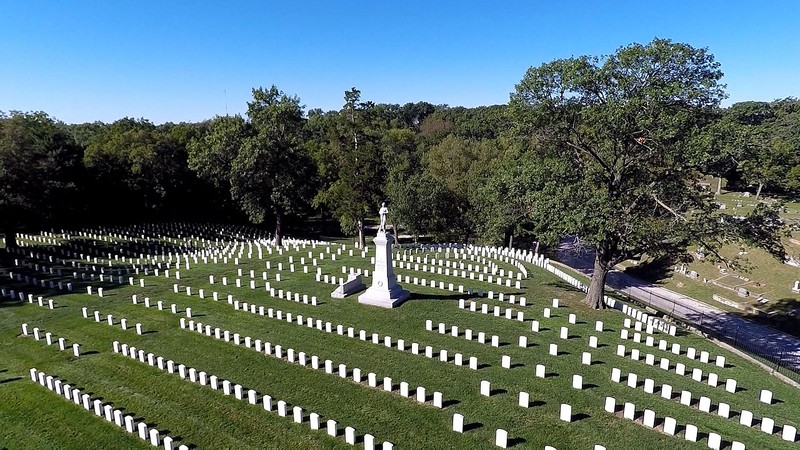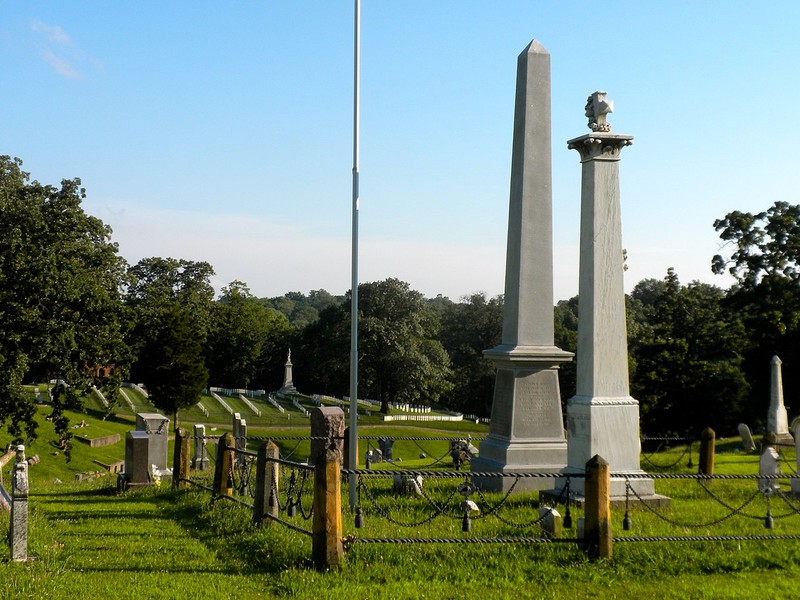Keokuk National Cemetery
Introduction
Text-to-speech Audio
One of 155 national cemeteries around the country, Keokuk National Cemetery was established in 1862 during the Civil War and contains the remains of more than 600 Union soldiers and eight Confederate prisoners of war. Veterans of subsequent wars and active duty service members are also buried here. It is 2.75 acres in size and is divided into two sections (east and west) with two separate entrances. The superintendent's lodge, which is in the eastern section, is a historic building erected in 1870 and designed by quartermaster General Montgomery C. Meigs in the Second Empire style. The cemetery was listed on the National Register of Historic Places in 1997.
Images
Over 600 Union soldiers and eight Confederate prisoners of war are buried in Keokuk National Cemetery, which was established during the Civil War. The Unknown Soldiers' Monument stands in the center of the picture.


Backstory and Context
Text-to-speech Audio
Keokuk was a bustling town of 13,000 at the start of the Civil War, having developed into a thriving economic hub thanks to its location at the confluence of the Mississippi and Des Moines Rivers. This made it a natural mustering point and shipping and transportation hub for the Union Army during the war. The first camp, Camp Ellsworth, was established in May 1861. Three more (Camp Rankin, Camp Halleck, and Camp Lincoln) were established by 1862.
During this time, the five hospitals, which were capable of accommodating a total of over 1,500 troops, were established to treat the increasing number of wounded and sick soldiers from battles in the South. One of these was a converted hotel called the Estes House. Those who died at the hospitals were buried in the cemetery, which was originally part of Oakland Cemetery. Private Pat Sullivan became the first Union soldier to be buried here in October 1861. The area where soldiers were laid to rest was known as the "Soldiers Burial Ground." The first significant number of wounded Union troops arrived in Keokuk after the Battle of Shiloh, which occurred on April 6, 1862 in Tennessee. Their arrival appears to be why, according to the National Cemetery Administration, that the cemetery's official date of establishment is 1862.
The federal government acquired the part of the Soldiers' Burial Ground after the war on August 28, 1866. It purchased additional properties to enlarge the cemetery to its current size in 1870 and 1874. In addition to the superintendent's lodge, an iron fence was built around the grounds, a flag pole surrounded by four artillery pieces was erected, and two cannons were placed at the entrance. In 1908, the remains of 73 individuals (52 soldiers, 12 children, 9 civilians) from Fort Yates, South Dakota were reinterred here. In 1912, the Women's Corps of Keokuk and the State of Iowa erected a 30-foot tall Unknown Soldiers Monument. In 1930, the cornerstone of the Estes Hotel, which no longer exists, was placed in the cemetery as a memorial to the soldiers who died at the hospital.
Sources
"History: General History." National Cemetery Administration. Accessed December 24, 2021. https://www.cem.va.gov/history/history.asp.
"Keokuk National Cemetery." National Cemetery Administration. Accessed December 24, 2021. https://www.cem.va.gov/CEM/cems/nchp/keokuk.asp.
"Keokuk National Cemetery." The Historical Marker Database. Accessed December 24, 2021. https://www.hmdb.org/m.asp?m=179354.
Sammartino, Therese T. "Keokuk National Cemetery." National Park Service - National Register of Historic Places Nomination Form. June 04, 1997. https://npgallery.nps.gov/GetAsset/0b4da6fe-187f-4b7a-a5f3-d51359fb4ab4.
Both images via Wikimedia Commons: https://commons.wikimedia.org/wiki/Category:Keokuk_National_Cemetery
